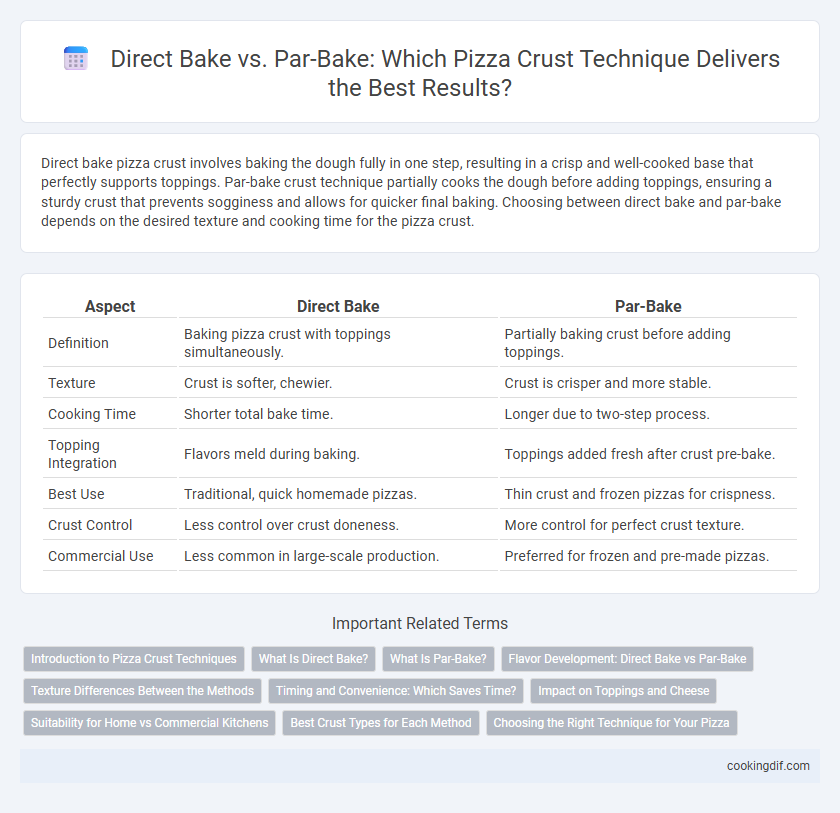Direct bake pizza crust involves baking the dough fully in one step, resulting in a crisp and well-cooked base that perfectly supports toppings. Par-bake crust technique partially cooks the dough before adding toppings, ensuring a sturdy crust that prevents sogginess and allows for quicker final baking. Choosing between direct bake and par-bake depends on the desired texture and cooking time for the pizza crust.
Table of Comparison
| Aspect | Direct Bake | Par-Bake |
|---|---|---|
| Definition | Baking pizza crust with toppings simultaneously. | Partially baking crust before adding toppings. |
| Texture | Crust is softer, chewier. | Crust is crisper and more stable. |
| Cooking Time | Shorter total bake time. | Longer due to two-step process. |
| Topping Integration | Flavors meld during baking. | Toppings added fresh after crust pre-bake. |
| Best Use | Traditional, quick homemade pizzas. | Thin crust and frozen pizzas for crispness. |
| Crust Control | Less control over crust doneness. | More control for perfect crust texture. |
| Commercial Use | Less common in large-scale production. | Preferred for frozen and pre-made pizzas. |
Introduction to Pizza Crust Techniques
Direct bake involves placing the pizza dough directly into the oven, creating a crispy and well-caramelized crust with a chewy interior. Par-bake, or partially baking the crust before adding toppings, ensures a structurally sound base that prevents sogginess and allows for a quicker final bake. Choosing between these methods depends on desired texture, topping moisture, and cooking time preferences.
What Is Direct Bake?
Direct bake is a pizza crust technique where the dough is baked fully in one step, ensuring a crispy and evenly cooked base. This method allows the crust to develop a golden-brown color and robust texture by baking the raw dough directly on a hot surface like a pizza stone or oven rack. Direct bake contrasts with par-bake, which partially cooks the crust before adding toppings and finishing the bake.
What Is Par-Bake?
Par-bake is a pizza crust technique where the dough is partially baked before adding toppings, ensuring a crispier and more stable base that prevents sogginess. This method allows for better moisture control and faster final baking times, making it ideal for pizzas with watery toppings like fresh tomatoes or vegetables. Par-baked crusts are commonly used in commercial kitchens to streamline preparation while maintaining quality and texture.
Flavor Development: Direct Bake vs Par-Bake
Direct bake enhances pizza crust flavor by allowing Maillard reactions to fully develop, creating a richer, more complex taste with caramelized edges and a slightly smoky aroma. Par-bake partially cooks the crust, locking moisture inside and improving texture but limiting the depth of flavor due to reduced browning during the final bake. Choosing direct bake maximizes flavor complexity, while par-bake prioritizes convenience and consistent crust texture.
Texture Differences Between the Methods
Direct bake creates a crust with a crisp, golden exterior and a chewy, tender interior by baking the dough fully in one step, allowing for maximum Maillard reaction and caramelization. Par-bake involves partially baking the crust before adding toppings, resulting in a firmer, less flexible base that reduces sogginess but may have a drier texture. The texture difference is significant: direct bake offers a traditional artisanal bite, while par-bake provides structural integrity suited for heavier toppings or advance preparation.
Timing and Convenience: Which Saves Time?
Direct bake pizza crusts require cooking the dough and toppings simultaneously, saving time by eliminating cooling and reheating steps commonly associated with par-baking. Par-baked crusts involve an initial partial bake, allowing for quicker final assembly and reheating, enhancing convenience in high-volume or make-ahead scenarios. Choosing direct bake optimizes speed for fresh orders, while par-baking offers efficiency and flexibility for batch preparation and storage.
Impact on Toppings and Cheese
Direct bake crusts develop a crisp texture that allows toppings and cheese to meld thoroughly, enhancing flavor integration and preventing sogginess. Par-baking sets the crust partially, preserving a firmer base that supports heavy or moisture-rich toppings without causing the crust to become overly soft. Cheese melts more evenly on directly baked crusts, while par-baked crusts offer greater control over topping doneness without compromising crust integrity.
Suitability for Home vs Commercial Kitchens
Direct bake crust techniques suit home kitchens by offering simplicity and shorter preparation times, ideal for individual or small-batch pizza making. Par-bake methods benefit commercial kitchens through consistent crust texture and faster final baking, supporting high-volume production and quick service. Efficiency in workflow and product consistency are key advantages in choosing par-bake for restaurants, while convenience and ease favor direct bake in home settings.
Best Crust Types for Each Method
Direct bake crusts work best with thin, Neapolitan-style doughs that benefit from rapid high-heat cooking, producing a crisp exterior and tender interior. Par-bake crusts suit thicker, Sicilian or deep-dish styles, allowing partial baking to set the dough before toppings are added, preventing sogginess. Whole wheat and gluten-free crusts also favor par-baking to maintain structure while ensuring even baking once fully topped.
Choosing the Right Technique for Your Pizza
Direct bake offers a crispy, fully cooked crust ideal for thin, artisanal pizzas, while par-bake provides a partially cooked base that prevents sogginess when adding moist toppings. Selecting the right technique depends on desired texture and toppings; par-baking is optimal for thick or heavily topped pizzas to maintain structural integrity. Understanding oven type, cooking time, and recipe specifics ensures perfect crust results whether using direct bake or par-bake methods.
Direct bake vs par-bake for crust technique Infographic

 cookingdif.com
cookingdif.com